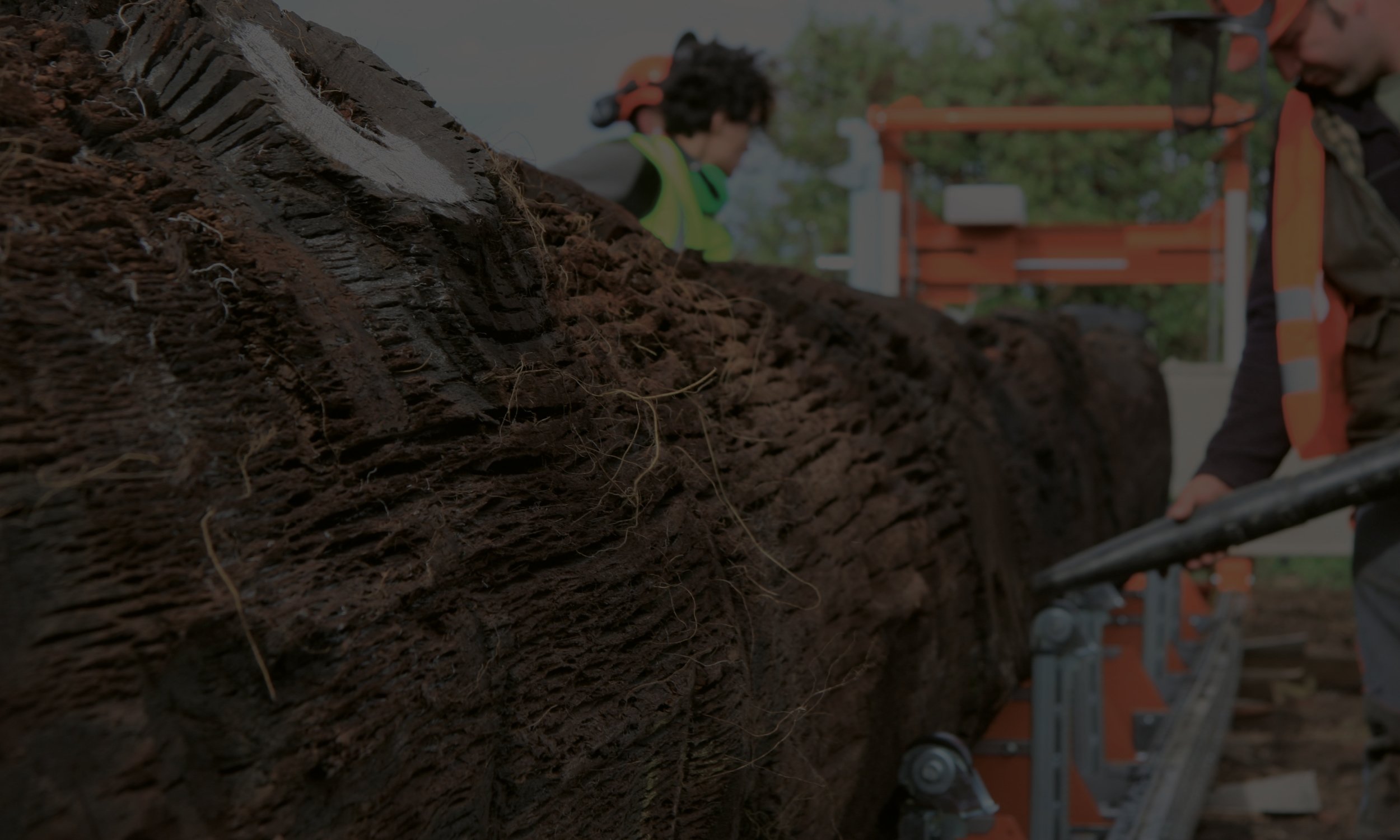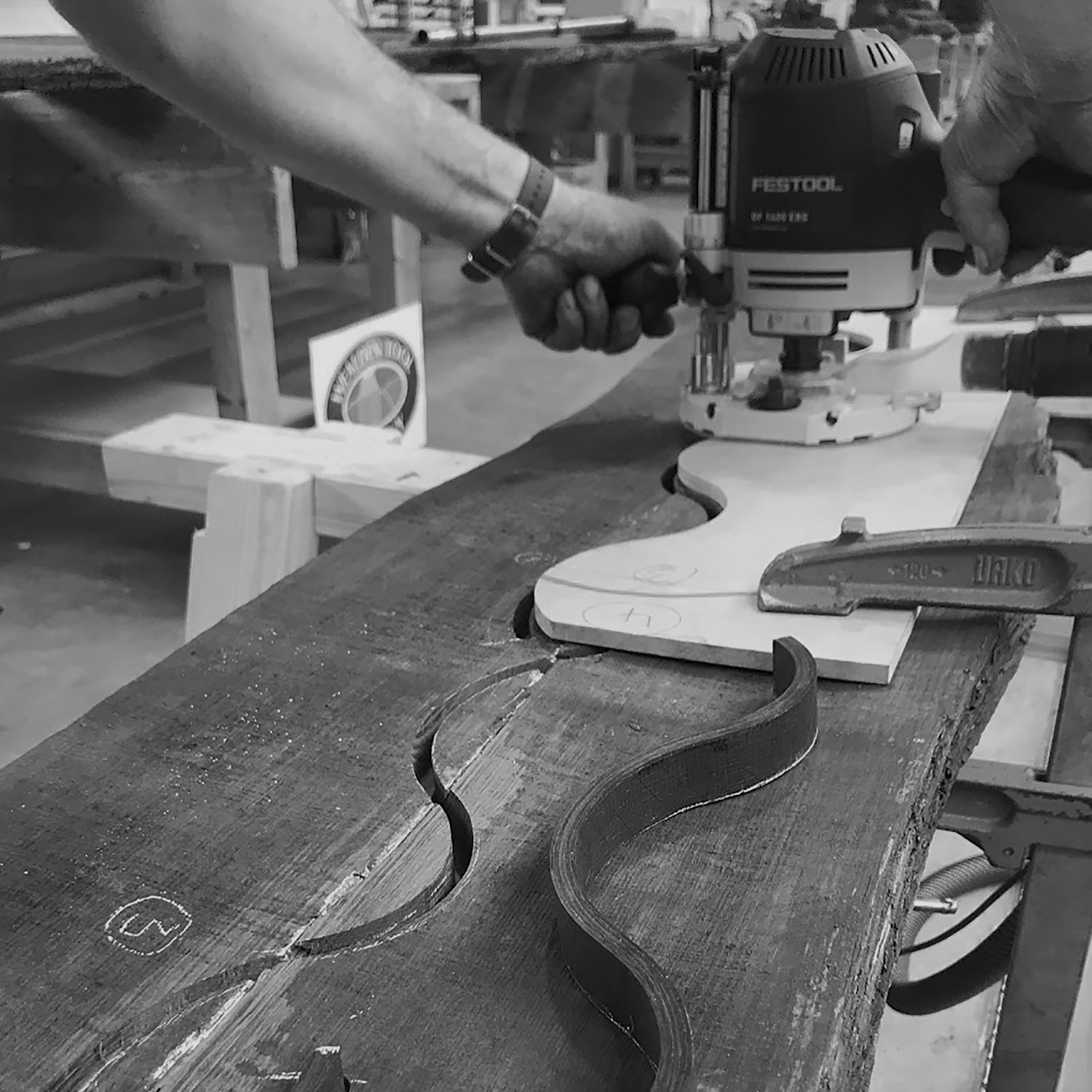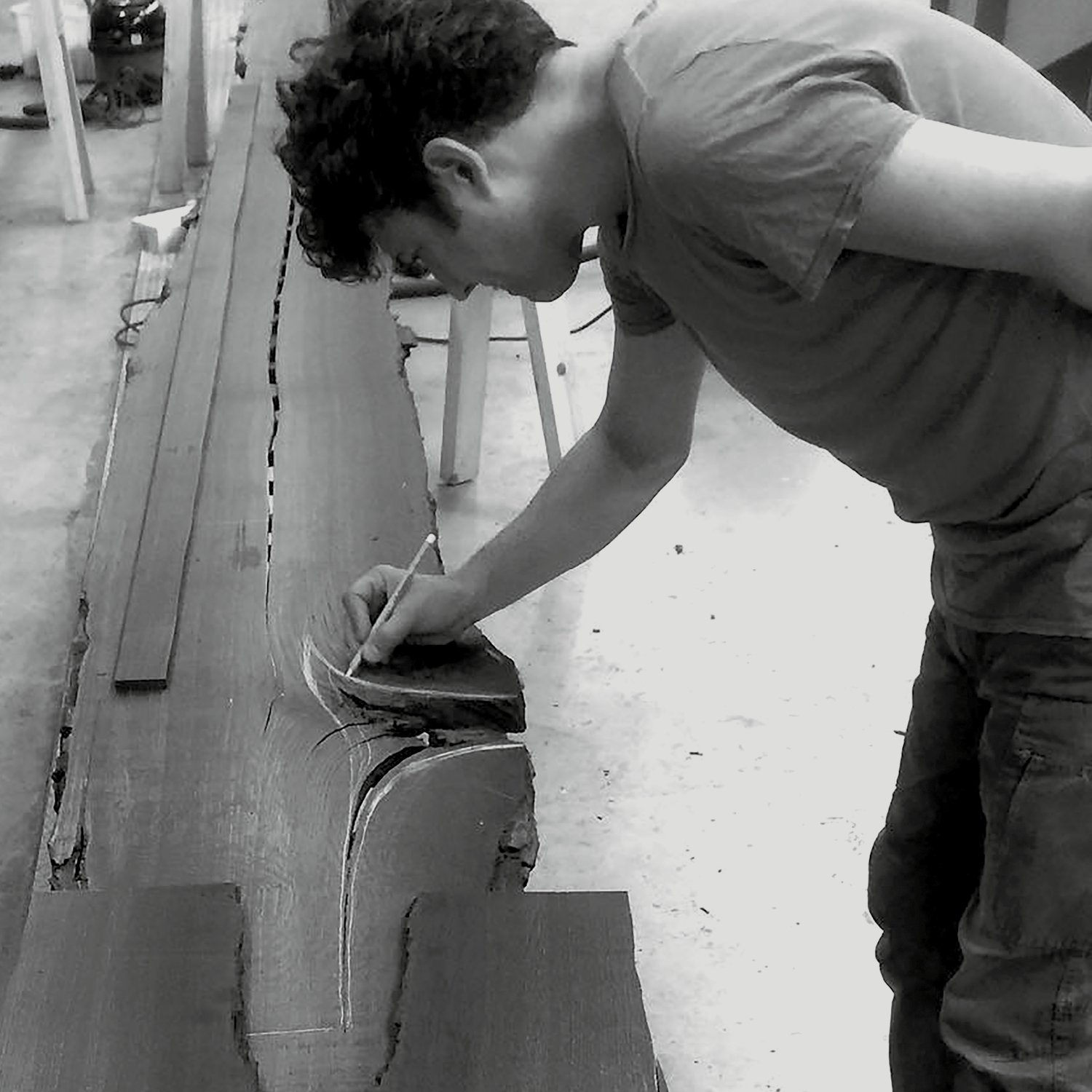
Our Story
How we transformed a 5000 year old Fenland Black Oak into a spectacular 13 metre long ‘Table for the Nation’.

The Jubilee Oak—
a giant amongst
giants
D I S C O V E R Y
During routine cultivations in the spring of 2012 on a farm in the Wissington Fens of south-west Norfolk, a 13.2 metre section of a 5,000 year old subfossilised Black Oak tree was unearthed. Discovered in the year of Queen Elizabeth II’s Diamond Jubilee, it is now known as the ‘Jubilee Oak’.
“I have been processing Black Oaks for over 30 years but when I saw the Jubilee Oak it took my breath away.
It was not just its size but the degree of preservation; there was no evidence of insect infestation or fungal disease, and large areas of bark were still intact.
It was not until I was asked which end was the canopy and which end was the root ball that we began to fully appreciate what we were looking at. This branchless tree was so parallel that we realised it was only a small section of a much, much bigger tree.
This explained the very unusual degree of preservation; when it fell, this vast tree would have smashed and crushed everything in its way before burying itself deep into the peat—where it lay, undisturbed, for the next 5000 years.”
Hamish Low
Expert on the preservation of Black Oak and project leader
Lifting the Jubilee Oak from the deep lowland peat
The Jubilee Oak exposed after 5000 years
“This magnificent tree represented the greatest creative opportunity to give a unique insight into the scale and majesty of our ancient high forests.”
—Hamish Low
Opening up
the Jubilee Oak
S A W M I L L I N G
With the aid of an excavator, two telehandlers (a type of telescopic forklift) and the longest sawmill in the country, some of the rarest planks in the world were milled from the Jubilee Oak. This posed several challenges.
We could not find a mobile sawmill in this country capable of milling such a huge tree, so a generous Canadian company via their UK agent loaned one. It proved easier to build the sawmill on site in the field rather than move the tree itself.
Since the Jubilee Oak had been buried for over 5000 years it was impossible to predict what this tree might gift to us when ‘opened up’. Nothing could have prepared us for what this extraordinary tree yielded. Ten magnificent, breathtakingly beautiful, consecutive planks unlike anything ever seen before.
The sawmill set up in the field where the Jubilee Oak was discovered
The astonishing creative potential of the timber yielded from Jubilee Oak
21 students and the Principal of the Building Crafts College carrying the first plank
Every one of these extraordinary planks represented a unique creative opportunity.
Preserved in
perpetuity
D R Y I N G
This was the most difficult challenge: Black Oak needs to be dried artificially and very slowly. Over a period of nine months, 1795 litres of water were extracted from the planks in a purpose-built dehumidifying kiln. The planks shrank to almost half their thickness, a quarter of their width and even 150 millimetres in length.
The drying process reduced the weight of the planks by a staggering 1.8 metric tonnes!
Once successfully dried out, the Jubilee Oak planks became even more precious and a charitable trust was established to protect them, the Fenland Black Oak CIO.
18 people required to move just one plank
The Jubilee Oak planks safely stacked in their bespoke drying kiln
Accuracy was critical with every element of the stack in the kiln
Black Oak must be dried artificially as traditional air drying is too aggressive.
A unique
creative
opportunity
D E S I G N
A multi disciplined design team was assembled under the direction of a lead designer to decide how best to preserve this incredibly rare discovery. So why did they decide on a table?
With a table, the Jubilee Oak planks could be kept at their full length and at the perfect height to be seen and touched in all their glory. Their majesty can be seen, unimpeded, from any angle.
As well as existing as a sculptural object in its own right, a table has many practical functions, such as for dining, meetings and display. A table can also be of huge symbolic value at important summits, traditional ceremonies and state events. It is, in so many ways, a perfect gift to the nation.
The design team had to come up with innovative and creative solutions to meet the various challenges of the design brief—not least that the table should be able to fold-down to mitigate its huge size, and that it should satisfy all the conservation concerns relating to the historical buildings in which it is likely to be housed.
Initial ideas of a cantilever design and a floating top
The concept design from lead designer Mauro Dell’Orco
A model of the drop-leaf concept
A model of the table at full width
Maintaining the full length integrity of these planks was at the very core of the design.
Making the
table top
C R E A T I O N
The planks were retained at full length and many new techniques were developed to work on their unprecedented size. The ‘River Joint’, for example, was created to not only reflect an important Fenland feature, but by using the shape and character of each individual plank, the scale of this tree can be fully appreciated at a glance. The unique visual details of the top are inspired entirely by the tree itself.

Selecting the dry planks for the table top

A unique stitching technique developed to stabilise the planks

The bespoke 28 metre planer bed moving in unison with the planing machine so generously loaned by a sponsor

Designing and making templates for the ‘river joint’

Lead craftsman Hamish Low explaining how they cut the river joints

Lead designer Mauro Dell’Orco drawing the shape of a patch

Inlaying by hand one of the many patches

Students and craftspeople working together on this unprecedented endeavour

The accuracy of the river joints
A wonderful collaboration between a team of dedicated master craftspeople, students and volunteers.
Creating an
understructure
worthy of the top
U N D E R S T R U C T U R E
The table’s understructure is made from patinated phosphor bronze, (archaeologists refer to the centuries after 3000BC as transitional between Stone and Bronze ages). Aside from its strength and beauty, it also helps with the smooth dismantling and rebuilding of the table as it moves from location to location.
The bronze hinges allow the two outer planks to be folded down, reducing the width of the table to just 900 millimetres, and the entire structure can then be wheeled effortlessly and silently by just two people to the side of a room and used as a serving table or for display. The River Joints are stunning when exposed in this way.
CGI of the table understructure
The two outer planks folded down and the table transformed into a serving table
CGI of the table understructure
Archaeologists refer to the centuries after 3000BC as transitional between Stone and Bronze ages so bronze was used for the understructure.
C O M P L E T I O N
Ely Cathedral is an iconic East Anglian landmark which is surrounded by fenland that still occasionally yields Black Oaks so the table has truly engaged with those living and working in the fens. Visitors were able to touch the table and enjoy the comprehensive exhibition panels which accompany the table.
Those that worked on the project were particularly honoured to unveil the table within the sacred space under the Cathedral’s world famous octagonal Lantern Tower and there are not many objects can hold their own in this space. This was the first opportunity to view the table in its entirety and to fully appreciate what they had all created.
The table’s 10 month residency inside the Cathedral was a great success and exceeded all expectations in terms of increased visitor numbers and sales of table related merchandise.
‘A Table for the Nation’
at Ely Cathedral
May 2022—March 2023
The two outer planks fold down reducing the table to half its width and can be moved by two people to the side of a space allowing other activities to take place
The vision for the table was always for it to sit centrally in the Lady Chapel, Ely Cathedral. The pale stone details in complete contrast with the gigantic black slab of the table top was magnificent
“We have been delighted to have The Black Oak Table in the Cathedral for the past ten months. It was a great honour to welcome the Princess Royal to the Cathedral to unveil it, and members of the team have been very generous in their time talking about its significance to several groups. The Table has generated a huge amount of interest, and visitors have been hugely engaged by its history and beauty, as well as the skill and craftsmanship has gone into its creation”.
—The Very Revd Mark Bonney, Dean of Ely
“Our anecdotal knowledge is that the table has been hugely popular and there is no doubt it has been a draw for visitors from far and wide throughout its residency.”
—Sally Porter, Visitor Experience Manager, Ely Cathedral
‘A Table for the Nation’
at Rochester Cathedral
March 2023—April 2024
R O C H E S T E R
Rochester Cathedral was the first to approach the Trustees of the Fenland Black Oak CIO for the second residency of the table. It is the second oldest cathedral in the country and welcomes around 300,000 visitors every year.
During its year-long residency, the table alternated between the Nave and the North and South Nave Aisles. The table proved very versatile and was moved often, becoming a popular spectacle in itself among visitors as it was manoeuvred up ramps and through seemingly impossible pinch points.
Rochester Cathedral is known for its inclusivity, and they were proactive in ensuring that the table was frequently used for a wide variety of activities. During its stay, the table hosted a multi-faith Iftar meal during Ramadan, the King’s Coronation with picnics and flags galore, numerous children’s activities, and brought together a variety of creative community groups for the first time.
All the diverse range of activities on and around the table involved many individuals who now proudly lay claim to an association with the Nation’s table. This is what it was made for, so a heartfelt thank you to all those at Rochester Cathedral who made this happen.
The Fenland Black Oak Table in the central Nave at Rochester Cathedral reflecting the Peace Doves above, by Peter Walker Sculptor
‘Come Eat With Me’ by Spirit Arts
A picnic celebrating the coronation of King Charles III
Rochester Cathedral Trust Nave dinner
A Demelza House fundraising dinner with floral display by Lisa Furnell
“It has been a real privilege to have had The Fenland Black Oak Table at Rochester for a year. We have grown accustomed to its presence and will miss it when it leaves for Lincoln.
It has been a huge success and played a central part in Cathedral’s life and worship.
We’ve had fabulous meals and conversations around its perfectly smooth edges, and hosted numerous events.
In all this we attempted to honour its description as ‘A Table for the Nation’ and have been as inclusive as possible. Events during the day were free giving access to all.
I hope the next stage of this amazing table’s journey brings as much pleasure as it has to the people of Medway and Kent. Go well!”
—The Very Reverend Dr Philip Hesketh DL, Dean of Rochester
L I N C O L N
Foundations for Lincoln Cathedral were laid in 1072 and in 1311 became the tallest building in the world. How fitting therefore that over 700 years later the Cathedral displayed a table made from the nation’s tallest and most ancient Oak tree.
Lincoln Cathedral have their own workshops training individuals and promoting traditional craft skills which has a shared work ethic with all those involved in the creation of the table.
Black Oaks are still occasionally unearthed from the Lincolnshire fens and the environmental and sustainability messages embodied by ‘A Table for the Nation’ played an active part in Lincoln Cathedral’s ‘Our world: God’s creation’ theme for 2024.
During its year-long residency, the table was placed for most of the time in the huge South Transept with the exhibition panels placed along the west wall so the table became a self contained visitor attraction in its own perfectly proportioned space. The table proved very versatile and was moved without the need for dismantling from the south transept to the North Transept, the Crossing, the Nave and the North and South Nave Aisles.
Lincoln Cathedral were proactive in ensuring that the table was frequently used for a wide variety of activities with local community groups embracing the opportunity to use the table in such a magnificent setting.



























